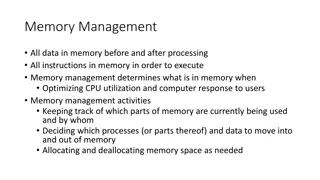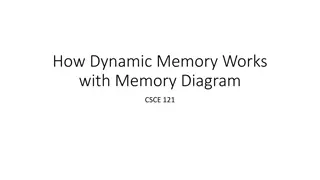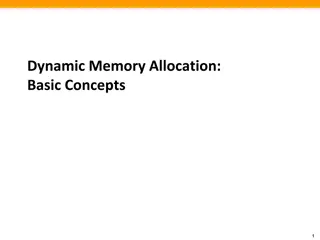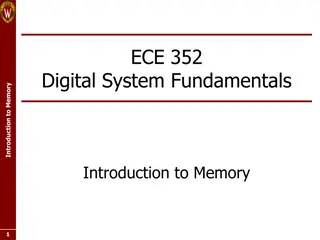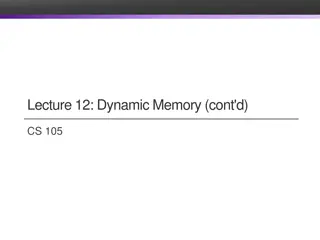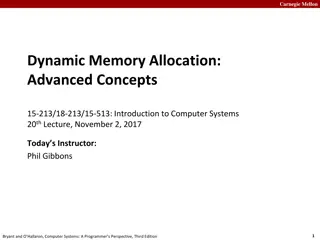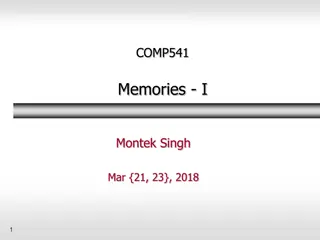Dynamic Memory Allocation in Computer Systems: An Overview
Dynamic memory allocation in computer systems involves the acquisition of virtual memory at runtime for data structures whose size is only known at runtime. This process is managed by dynamic memory allocators, such as malloc, to handle memory invisible to user code, application kernels, and virtual memory stacks. The runtime heap, managed by malloc, plays a crucial role in the dynamic memory allocation process, along with memory-mapped regions and segments like data, bss, init, text, and rodata.
Download Presentation

Please find below an Image/Link to download the presentation.
The content on the website is provided AS IS for your information and personal use only. It may not be sold, licensed, or shared on other websites without obtaining consent from the author.If you encounter any issues during the download, it is possible that the publisher has removed the file from their server.
You are allowed to download the files provided on this website for personal or commercial use, subject to the condition that they are used lawfully. All files are the property of their respective owners.
The content on the website is provided AS IS for your information and personal use only. It may not be sold, licensed, or shared on other websites without obtaining consent from the author.
E N D
Presentation Transcript
Carnegie Mellon 14-513 18 18- -613 613 1 Bryant and O Hallaron, Computer Systems: A Programmer s Perspective, Third Edition
Carnegie Mellon Dynamic Memory Allocation: Advanced Concepts 14-513/18-613: Introduction to Computer Systems 15th Lecture, June 18, 2020 2 Bryant and O Hallaron, Computer Systems: A Programmer s Perspective, Third Edition
Carnegie Mellon 3 Bryant and O Hallaron, Computer Systems: A Programmer s Perspective, Third Edition
Carnegie Mellon 4 Bryant and O Hallaron, Computer Systems: A Programmer s Perspective, Third Edition
Carnegie Mellon 5 Bryant and O Hallaron, Computer Systems: A Programmer s Perspective, Third Edition
Carnegie Mellon 6 Bryant and O Hallaron, Computer Systems: A Programmer s Perspective, Third Edition
Carnegie Mellon 7 Bryant and O Hallaron, Computer Systems: A Programmer s Perspective, Third Edition
Carnegie Mellon 8 Bryant and O Hallaron, Computer Systems: A Programmer s Perspective, Third Edition
Carnegie Mellon 9 Bryant and O Hallaron, Computer Systems: A Programmer s Perspective, Third Edition
Carnegie Mellon Review: Dynamic Memory Allocation Memory invisible to user code Application Kernel virtual memory User stack (created at runtime) Dynamic Memory Allocator %rsp (stack pointer) Heap Programmers use dynamic memory allocators (such as malloc) to acquire virtual memory (VM) at run time. for data structures whose size is only known at runtime Memory-mapped region for shared libraries brk Run-time heap (created by malloc) Loaded from the executable file Read/write segment (.data, .bss) Dynamic memory allocators manage an area of process VM known as the heap. Read-only segment (.init, .text, .rodata) 0x400000 Unused 0 10 Bryant and O Hallaron, Computer Systems: A Programmer s Perspective, Third Edition
Carnegie Mellon Review: Keeping Track of Free Blocks Method 1: Implicit list using length links all blocks Need to tag each block as allocated/free Unused 32 16 48 32 Method 2: Explicit list among the free blocks using pointers Need space for pointers 32 16 48 32 Method 3: Segregated free list Different free lists for different size classes Method 4: Blocks sorted by size Can use a balanced tree (e.g. Red-Black tree) with pointers within each free block, and the length used as a key 11 Bryant and O Hallaron, Computer Systems: A Programmer s Perspective, Third Edition
Carnegie Mellon Review: Implicit Lists Summary Implementation: very simple Allocate cost: linear time worst case Free cost: constant time worst case even with coalescing Memory Overhead: Depends on placement policy Strategies include first fit, next fit, and best fit Not used in practice for malloc/free because of linear- time allocation used in many special purpose applications However, the concepts of splitting and boundary tag coalescing are general to all allocators 12 Bryant and O Hallaron, Computer Systems: A Programmer s Perspective, Third Edition
Carnegie Mellon Today Explicit free lists Segregated free lists Garbage collection Memory-related perils and pitfalls 13 Bryant and O Hallaron, Computer Systems: A Programmer s Perspective, Third Edition
Carnegie Mellon Keeping Track of Free Blocks Method 1: Implicit list using length links all blocks Unused 32 16 48 32 Method 2: Explicit list among the free blocks using pointers 32 16 48 32 Method 3: Segregated free list Different free lists for different size classes Method 4: Blocks sorted by size Can use a balanced tree (e.g. Red-Black tree) with pointers within each free block, and the length used as a key 14 Bryant and O Hallaron, Computer Systems: A Programmer s Perspective, Third Edition
Carnegie Mellon Explicit Free Lists Free Allocated (as before) Size a Size a Next Prev Payload and padding Optional Size a Size a Maintain list(s) of free blocks, not all blocks Luckily we track only free blocks, so we can use payload area The next free block could be anywhere So we need to store forward/back pointers, not just sizes Still need boundary tags for coalescing To find adjacent blocks according to memory order 15 Bryant and O Hallaron, Computer Systems: A Programmer s Perspective, Third Edition
Carnegie Mellon Explicit Free Lists Logically: A B C Physically: blocks can be in any order Forward (next) links A B 32 32 32 32 48 48 32 32 32 32 C Back (prev) links 16 Bryant and O Hallaron, Computer Systems: A Programmer s Perspective, Third Edition
Carnegie Mellon Allocating From Explicit Free Lists conceptual graphic Before After (with splitting) = malloc( ) 17 Bryant and O Hallaron, Computer Systems: A Programmer s Perspective, Third Edition
Carnegie Mellon Freeing With Explicit Free Lists Insertion policy: Where in the free list do you put a newly freed block? Unordered LIFO (last-in-first-out) policy Insert freed block at the beginning of the free list FIFO (first-in-first-out) policy Insert freed block at the end of the free list Pro: simple and constant time Con: studies suggest fragmentation is worse than address ordered Address-ordered policy Insert freed blocks so that free list blocks are always in address order: addr(prev) < addr(curr) < addr(next) Con: requires search Pro: studies suggest fragmentation is lower than LIFO/FIFO 18 Bryant and O Hallaron, Computer Systems: A Programmer s Perspective, Third Edition
Carnegie Mellon Freeing With a LIFO Policy (Case 1) Allocated Allocated conceptual graphic Before free( ) Root Insert the freed block at the root of the list After Root 19 Bryant and O Hallaron, Computer Systems: A Programmer s Perspective, Third Edition
Carnegie Mellon Freeing With a LIFO Policy (Case 2) Allocated Free conceptual graphic Before free( ) Root Splice out adjacent successor block, coalesce both memory blocks, and insert the new block at the root of the list After Root 20 Bryant and O Hallaron, Computer Systems: A Programmer s Perspective, Third Edition
Carnegie Mellon Freeing With a LIFO Policy (Case 3) Free Allocated conceptual graphic Before free( ) Root Splice out adjacent predecessor block, coalesce both memory blocks, and insert the new block at the root of the list After Root 21 Bryant and O Hallaron, Computer Systems: A Programmer s Perspective, Third Edition
Carnegie Mellon Freeing With a LIFO Policy (Case 4) Free Free conceptual graphic Before free( ) Root Splice out adjacent predecessor and successor blocks, coalesce all 3 blocks, and insert the new block at the root of the list After Root 22 Bryant and O Hallaron, Computer Systems: A Programmer s Perspective, Third Edition
Carnegie Mellon Some Advice: An Implementation Trick LIFO Insertion Point FIFO Insertion Point A B C D Free Next fit Pointer Use circular, doubly-linked list Support multiple approaches with single data structure First-fit vs. next-fit Either keep free pointer fixed or move as search list LIFO vs. FIFO Insert as next block (LIFO), or previous block (FIFO) 23 Bryant and O Hallaron, Computer Systems: A Programmer s Perspective, Third Edition
Carnegie Mellon Explicit List Summary Comparison to implicit list: Allocate is linear time in number of free blocks instead of all blocks Much faster when most of the memory is full Slightly more complicated allocate and free because need to splice blocks in and out of the list Some extra space for the links (2 extra words needed for each block) Does this increase internal fragmentation? 24 Bryant and O Hallaron, Computer Systems: A Programmer s Perspective, Third Edition
Carnegie Mellon Today Explicit free lists Segregated free lists Garbage collection Memory-related perils and pitfalls 25 Bryant and O Hallaron, Computer Systems: A Programmer s Perspective, Third Edition
Carnegie Mellon Segregated List (Seglist) Allocators Each size class of blocks has its own free list 16 32-48 64 inf Often have separate classes for each small size For larger sizes: One class for each size [??+ ?,??+?] 26 Bryant and O Hallaron, Computer Systems: A Programmer s Perspective, Third Edition
Carnegie Mellon Seglist Allocator Given an array of free lists, each one for some size class To allocate a block of size n: Search appropriate free list for block of size m > n (i.e., first fit) If an appropriate block is found: Split block and place fragment on appropriate list If no block is found, try next larger class Repeat until block is found If no block is found: Request additional heap memory from OS (using sbrk()) Allocate block of n bytes from this new memory Place remainder as a single free block in appropriate size class. 27 Bryant and O Hallaron, Computer Systems: A Programmer s Perspective, Third Edition
Carnegie Mellon Seglist Allocator (cont.) To free a block: Coalesce and place on appropriate list Advantages of seglist allocators vs. non-seglist allocators (both with first-fit) Higher throughput log time for power-of-two size classes vs. linear time Better memory utilization First-fit search of segregated free list approximates a best-fit search of entire heap. Extreme case: Giving each block its own size class is equivalent to best-fit. 28 Bryant and O Hallaron, Computer Systems: A Programmer s Perspective, Third Edition
Carnegie Mellon More Info on Allocators D. Knuth, The Art of Computer Programming, vol 1, 3rd edition, Addison Wesley, 1997 The classic reference on dynamic storage allocation Wilson et al, Dynamic Storage Allocation: A Survey and Critical Review , Proc. 1995 Int l Workshop on Memory Management, Kinross, Scotland, Sept, 1995. Comprehensive survey Available from CS:APP student site (csapp.cs.cmu.edu) 29 Bryant and O Hallaron, Computer Systems: A Programmer s Perspective, Third Edition
Carnegie Mellon Today Explicit free lists Segregated free lists Garbage collection Memory-related perils and pitfalls 30 Bryant and O Hallaron, Computer Systems: A Programmer s Perspective, Third Edition
Carnegie Mellon Implicit Memory Management: Garbage Collection Garbage collection: automatic reclamation of heap-allocated storage application never has to explicitly free memory void foo() { int *p = malloc(128); return; /* p block is now garbage */ } Common in many dynamic languages: Python, Ruby, Java, Perl, ML, Lisp, Mathematica Variants ( conservative garbage collectors) exist for C and C++ However, cannot necessarily collect all garbage 31 Bryant and O Hallaron, Computer Systems: A Programmer s Perspective, Third Edition
Carnegie Mellon Garbage Collection How does the memory manager know when memory can be freed? In general we cannot know what is going to be used in the future since it depends on conditionals But we can tell that certain blocks cannot be used if there are no pointers to them Must make certain assumptions about pointers Memory manager can distinguish pointers from non-pointers All pointers point to the start of a block Cannot hide pointers (e.g., by coercing them to an int, and then back again) 32 Bryant and O Hallaron, Computer Systems: A Programmer s Perspective, Third Edition
Carnegie Mellon Classical GC Algorithms Mark-and-sweep collection (McCarthy, 1960) Does not move blocks (unless you also compact ) Reference counting (Collins, 1960) Does not move blocks (not discussed) Copying collection (Minsky, 1963) Moves blocks (not discussed) Generational Collectors (Lieberman and Hewitt, 1983) Collection based on lifetimes Most allocations become garbage very soon So focus reclamation work on zones of memory recently allocated For more information: Jones and Lin, Garbage Collection: Algorithms for Automatic Dynamic Memory , John Wiley & Sons, 1996. 33 Bryant and O Hallaron, Computer Systems: A Programmer s Perspective, Third Edition
Carnegie Mellon Memory as a Graph We view memory as a directed graph Each block is a node in the graph Each pointer is an edge in the graph Locations not in the heap that contain pointers into the heap are called root nodes (e.g. registers, locations on the stack, global variables) Root nodes Heap nodes reachable Not-reachable (garbage) A node (block) is reachable if there is a path from any root to that node. Non-reachable nodes are garbage (cannot be needed by the application) 34 Bryant and O Hallaron, Computer Systems: A Programmer s Perspective, Third Edition
Carnegie Mellon Mark and Sweep Collecting Can build on top of malloc/free package Allocate using mallocuntil you run out of space When out of space: Use extra mark bitin the head of each block Mark: Start at roots and set mark bit on each reachable block Sweep: Scan all blocks and free blocks that are not marked root Note: arrows here denote memory refs, not free list ptrs. Before mark After mark Mark bit set After sweep free free 35 Bryant and O Hallaron, Computer Systems: A Programmer s Perspective, Third Edition
Carnegie Mellon Assumptions For a Simple Implementation Application new(n): returns pointer to new block with all locations cleared read(b,i):read location i of block b into register write(b,i,v): write v into location i of block b Each block will have a header word addressed as b[-1], for a block b Used for different purposes in different collectors Instructions used by the Garbage Collector is_ptr(p): determines whether p is a pointer length(b): returns the length of block b, not including the header get_roots(): returns all the roots 36 Bryant and O Hallaron, Computer Systems: A Programmer s Perspective, Third Edition
Carnegie Mellon Mark and Sweep Pseudocode Mark using depth-first traversal of the memory graph ptr mark(ptr p) { if (!is_ptr(p)) return; // if not pointer -> do nothing if (markBitSet(p)) return; // if already marked -> do nothing setMarkBit(p); // set the mark bit for (i=0; i < length(p); i++) // recursively call mark on all words mark(p[i]); // in the block return; } 37 Bryant and O Hallaron, Computer Systems: A Programmer s Perspective, Third Edition
Carnegie Mellon Mark and Sweep Pseudocode Mark using depth-first traversal of the memory graph ptr mark(ptr p) { if (!is_ptr(p)) return; // if not pointer -> do nothing if (markBitSet(p)) return; // if already marked -> do nothing setMarkBit(p); // set the mark bit for (i=0; i < length(p); i++) // recursively call mark on all words mark(p[i]); // in the block return; } 38 Bryant and O Hallaron, Computer Systems: A Programmer s Perspective, Third Edition
Carnegie Mellon Mark and Sweep Pseudocode Mark using depth-first traversal of the memory graph ptr mark(ptr p) { if (!is_ptr(p)) return; // if not pointer -> do nothing if (markBitSet(p)) return; // if already marked -> do nothing setMarkBit(p); // set the mark bit for (i=0; i < length(p); i++) // recursively call mark on all words mark(p[i]); // in the block return; } 39 Bryant and O Hallaron, Computer Systems: A Programmer s Perspective, Third Edition
Carnegie Mellon Mark and Sweep Pseudocode Mark using depth-first traversal of the memory graph ptr mark(ptr p) { if (!is_ptr(p)) return; // if not pointer -> do nothing if (markBitSet(p)) return; // if already marked -> do nothing setMarkBit(p); // set the mark bit for (i=0; i < length(p); i++) // recursively call mark on all words mark(p[i]); // in the block return; } 40 Bryant and O Hallaron, Computer Systems: A Programmer s Perspective, Third Edition
Carnegie Mellon Mark and Sweep Pseudocode Mark using depth-first traversal of the memory graph ptr mark(ptr p) { if (!is_ptr(p)) return; // if not pointer -> do nothing if (markBitSet(p)) return; // if already marked -> do nothing setMarkBit(p); // set the mark bit for (i=0; i < length(p); i++) // for each word in p s block mark(p[i]); return; } 41 Bryant and O Hallaron, Computer Systems: A Programmer s Perspective, Third Edition
Carnegie Mellon Mark and Sweep Pseudocode Mark using depth-first traversal of the memory graph ptr mark(ptr p) { if (!is_ptr(p)) return; // if not pointer -> do nothing if (markBitSet(p)) return; // if already marked -> do nothing setMarkBit(p); // set the mark bit for (i=0; i < length(p); i++) // for each word in p s block mark(p[i]); // make recursive call return; } 42 Bryant and O Hallaron, Computer Systems: A Programmer s Perspective, Third Edition
Carnegie Mellon Mark and Sweep Pseudocode Mark using depth-first traversal of the memory graph ptr mark(ptr p) { if (!is_ptr(p)) return; // if not pointer -> do nothing if (markBitSet(p)) return; // if already marked -> do nothing setMarkBit(p); // set the mark bit for (i=0; i < length(p); i++) // for each word in p s block mark(p[i]); // make recursive call return; } Sweep using lengths to find next block ptr sweep(ptr p, ptr end) { while (p < end) { if markBitSet(p) clearMarkBit(); else if (allocateBitSet(p)) free(p); p += length(p+1); } // for entire heap 43 Bryant and O Hallaron, Computer Systems: A Programmer s Perspective, Third Edition
Carnegie Mellon Mark and Sweep Pseudocode Mark using depth-first traversal of the memory graph ptr mark(ptr p) { if (!is_ptr(p)) return; // if not pointer -> do nothing if (markBitSet(p)) return; // if already marked -> do nothing setMarkBit(p); // set the mark bit for (i=0; i < length(p); i++) // for each word in p s block mark(p[i]); // make recursive call return; } Sweep using lengths to find next block ptr sweep(ptr p, ptr end) { while (p < end) { if markBitSet(p) clearMarkBit(); else if (allocateBitSet(p)) free(p); p += length(p+1); } // for entire heap // did we reach this block? 44 Bryant and O Hallaron, Computer Systems: A Programmer s Perspective, Third Edition
Carnegie Mellon Mark and Sweep Pseudocode Mark using depth-first traversal of the memory graph ptr mark(ptr p) { if (!is_ptr(p)) return; // if not pointer -> do nothing if (markBitSet(p)) return; // if already marked -> do nothing setMarkBit(p); // set the mark bit for (i=0; i < length(p); i++) // for each word in p s block mark(p[i]); // make recursive call return; } Sweep using lengths to find next block ptr sweep(ptr p, ptr end) { while (p < end) { if markBitSet(p) clearMarkBit(); else if (allocateBitSet(p)) free(p); p += length(p+1); } // for entire heap // did we reach this block? // yes -> so just clear mark bit 45 Bryant and O Hallaron, Computer Systems: A Programmer s Perspective, Third Edition
Carnegie Mellon Mark and Sweep Pseudocode Mark using depth-first traversal of the memory graph ptr mark(ptr p) { if (!is_ptr(p)) return; // if not pointer -> do nothing if (markBitSet(p)) return; // if already marked -> do nothing setMarkBit(p); // set the mark bit for (i=0; i < length(p); i++) // for each word in p s block mark(p[i]); // make recursive call return; } Sweep using lengths to find next block ptr sweep(ptr p, ptr end) { while (p < end) { if markBitSet(p) clearMarkBit(); else if (allocateBitSet(p)) // never reached: is it allocated? free(p); p += length(p+1); } // for entire heap // did we reach this block? // yes -> so just clear mark bit 46 Bryant and O Hallaron, Computer Systems: A Programmer s Perspective, Third Edition
Carnegie Mellon Mark and Sweep Pseudocode Mark using depth-first traversal of the memory graph ptr mark(ptr p) { if (!is_ptr(p)) return; // if not pointer -> do nothing if (markBitSet(p)) return; // if already marked -> do nothing setMarkBit(p); // set the mark bit for (i=0; i < length(p); i++) // for each word in p s block mark(p[i]); // make recursive call return; } Sweep using lengths to find next block ptr sweep(ptr p, ptr end) { while (p < end) { if markBitSet(p) clearMarkBit(); else if (allocateBitSet(p)) // never reached: is it allocated? free(p); // yes -> its garbage, free it p += length(p+1); } // for entire heap // did we reach this block? // yes -> so just clear mark bit 47 Bryant and O Hallaron, Computer Systems: A Programmer s Perspective, Third Edition
Carnegie Mellon Mark and Sweep Pseudocode Mark using depth-first traversal of the memory graph ptr mark(ptr p) { if (!is_ptr(p)) return; // if not pointer -> do nothing if (markBitSet(p)) return; // if already marked -> do nothing setMarkBit(p); // set the mark bit for (i=0; i < length(p); i++) // for each word in p s block mark(p[i]); // make recursive call return; } Sweep using lengths to find next block ptr sweep(ptr p, ptr end) { while (p < end) { if markBitSet(p) clearMarkBit(); else if (allocateBitSet(p)) // never reached: is it allocated? free(p); // yes -> its garbage, free it p += length(p+1); // goto next block } // for entire heap // did we reach this block? // yes -> so just clear mark bit 48 Bryant and O Hallaron, Computer Systems: A Programmer s Perspective, Third Edition
Carnegie Mellon Today Explicit free lists Segregated free lists Garbage collection Memory-related perils and pitfalls 49 Bryant and O Hallaron, Computer Systems: A Programmer s Perspective, Third Edition
Carnegie Mellon Memory-Related Perils and Pitfalls Dereferencing bad pointers Reading uninitialized memory Overwriting memory Referencing nonexistent variables Freeing blocks multiple times Referencing freed blocks Failing to free blocks 50 Bryant and O Hallaron, Computer Systems: A Programmer s Perspective, Third Edition












